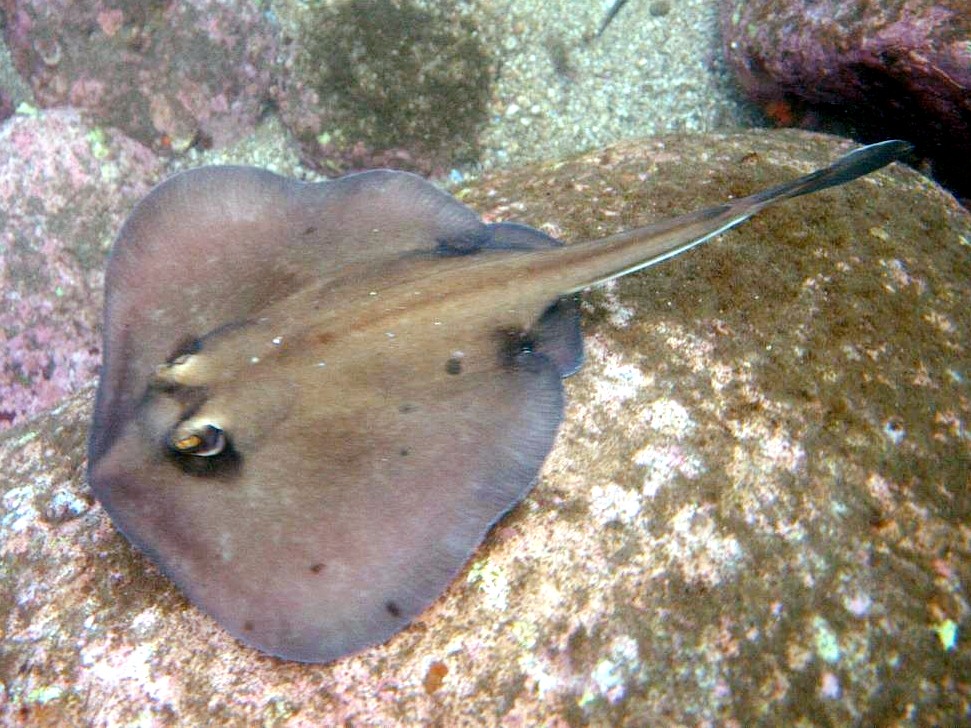Kapala stingaree
A species of Coral sea stingaree Scientific name : Urolophus kapalensis Genus : Coral sea stingaree
Kapala stingaree, A species of Coral sea stingaree
Botanical name: Urolophus kapalensis
Genus: Coral sea stingaree
Content
Description
 Photo By Taso Viglas , used under CC-BY-2.0 /Cropped and compressed from original
Photo By Taso Viglas , used under CC-BY-2.0 /Cropped and compressed from original Description
The pectoral fin disc of the Kapala stingaree is more or less diamond-shaped with rounded outer corners and posterior margins, and is slightly wider than long. The leading margins of the disc are nearly straight and converge at an obtuse angle on the fleshy, barely protruding snout. The eyes are of modest size and followed by teardrop-shaped spiracles with rounded posterior rims. There is a subtle knob on the rear margin of each nostril. Between the nostrils is a bell-shaped curtain of skin, with the posterior margin shallowly fringed and corners elongated into lobes; only the sparsely-spotted stingaree (U. paucimaculatus) has a similarly shaped nasal curtain. The mouth is small and contains 5–7 papillae (nipple-like structure) arranged in a W-shaped pattern on the floor. The lower jaw also bears a patch of prominent papillae, arranged to form a series of transverse ridges. The teeth have rhomboid bases and are arranged in a quincunx pattern; the crowns are blunt for teeth at the sides of the jaws, becoming higher and more pointed towards the middle of the jaw. There are 25 upper and 31–32 lower tooth rows. The five pairs of gill slits are S-shaped. The pelvic fins are small with rounded rear margins; males have short, stout claspers. The slender, flattened tail measures 82–90% as long as the disc, and terminates in a low, leaf-shaped caudal fin; there is a prominent skin fold running along each side. A very thin, serrated stinging spine is positioned atop the tail about halfway along its length; immediate in front is a long, low dorsal fin. The skin entirely lacks dermal denticles. The Kapala stingaree is greenish above, becoming pinkish toward the disc margins, and bears a variable pattern of dark markings that usually include a triangular blotch beneath each eye, a V-shaped bar between the eyes, a blotch at the base of the pelvic fins, and a pair of blotches in the middle of the disc that extend into stripes that run onto the tail. Not all individuals have all of these markings, and a few may be mottled or almost black on top. The underside is off-white with a wide, dusky band around the disc margin. The tail is pale with a dark midline stripe above and sometimes scattered dark blotches below; the dorsal fin is greenish and the caudal fin is light with a dark edge in adults, and entirely dark in juveniles. The largest known specimen measures 51 cm (20 in) long.
* Disclaimer: The judgment on toxicity and danger is for reference only. We DO NOT GUARANTEE any accuracy of such judgment. Therefore, you SHALL NOT rely on such judgment. It is IMPORTANT TO SEEK PROFESSIONAL ADVICE in advance when necessary.
Scientific Classification
Phylum
Chordates Class
Sharks and rays Order
Stingrays and relatives Family
Stingarees Genus
Coral sea stingaree Species
Kapala stingaree